AI Video Analytics Market Size
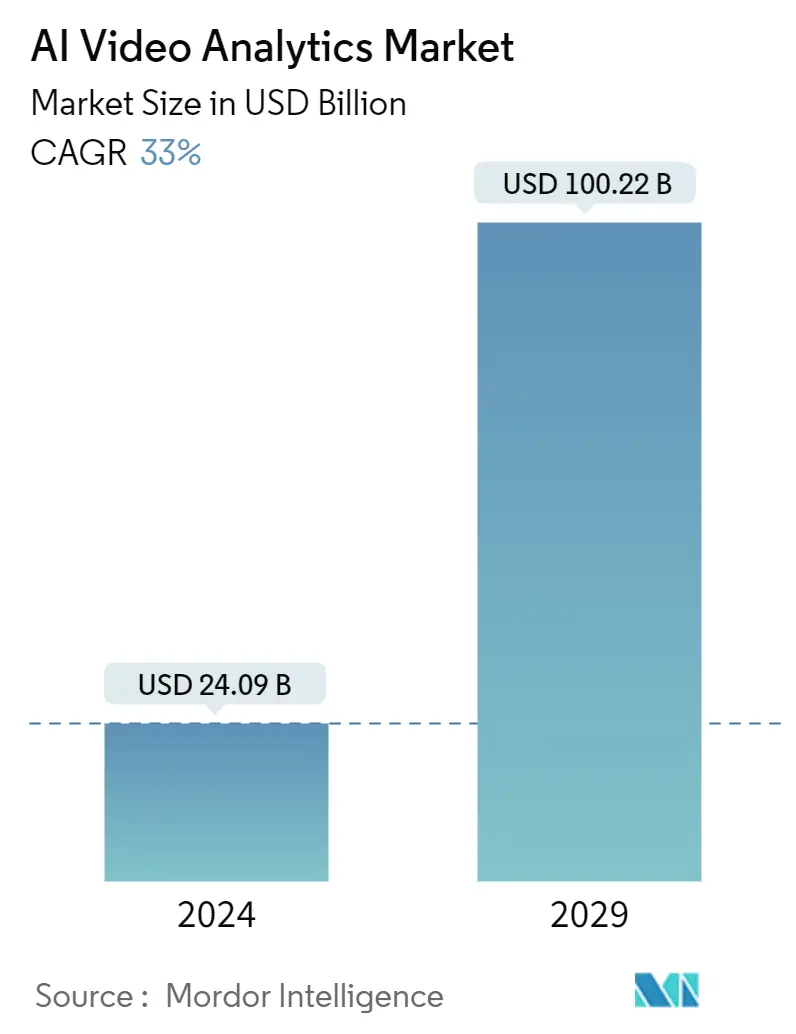
| Study Period | 2019 - 2029 |
| Market Size (2024) | USD 24.09 Billion |
| Market Size (2029) | USD 100.22 Billion |
| CAGR (2024 - 2029) | 33.00 % |
| Fastest Growing Market | Asia-Pacific |
| Largest Market | North America |
Major Players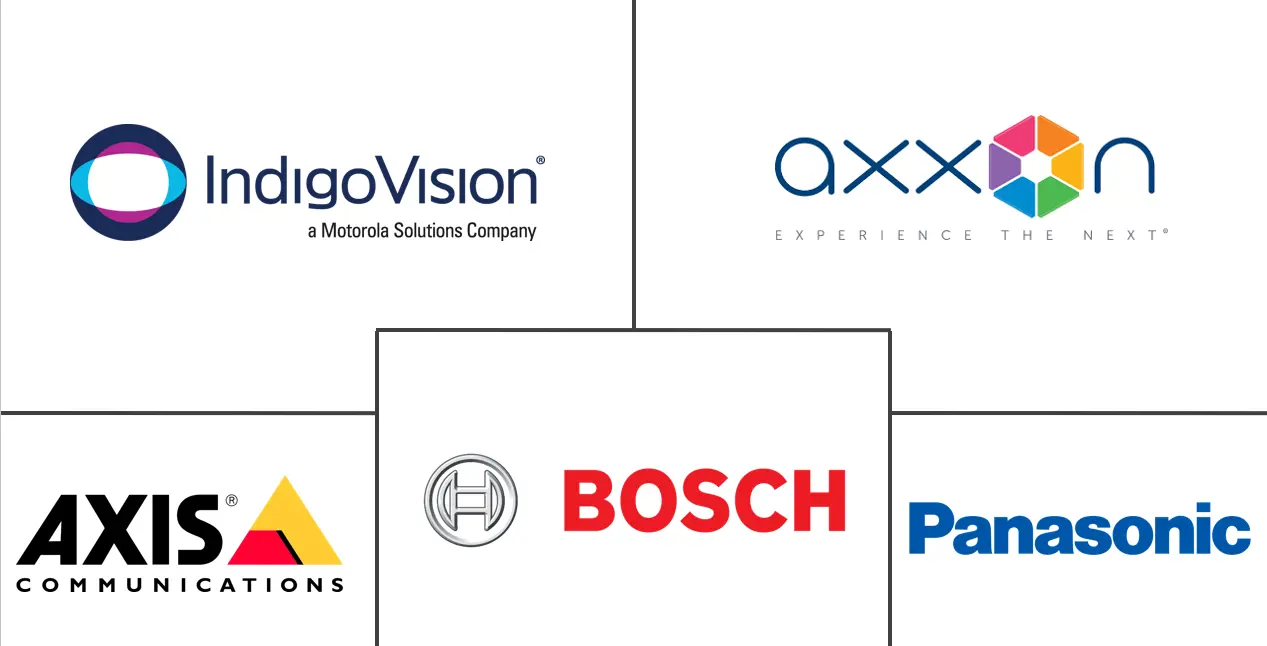
*Disclaimer: Major Players sorted in no particular order |
AI Video Analytics Market Analysis
The AI Video Analytics Market size is estimated at USD 24.09 billion in 2024, and is expected to reach USD 100.22 billion by 2029, growing at a CAGR of 33% during the forecast period (2024-2029).
The governments of numerous countries are rapidly using AI-based video analytic systems for traffic monitoring and in public infrastructures to improve residents' security and safety. The growing use of video surveillance in commercial buildings such as malls, airports, railway stations, ports, and so on, as well as residential structures, has boosted the demand for visual analytics.
- The advancements in intelligent software have outpaced traditional monitoring techniques. The sophisticated surveillance systems can be used in the provided area and have widespread self-learning capabilities. Al can watch the security cameras round-the-clock. Additionally, it can offer in-the-moment analysis, map, track, control shady movement, and save lives. To give the general public a safe environment, the governments of numerous nations are putting surveillance infrastructure in place. Al's potential for usage in healthcare software and smart homes could also spur market growth for video analytics. These factors could all have an impact on Al's growth in the market for video analytics.
- AI video analytics is becoming an increasingly important tool for the defense industry, with many companies and government agencies exploring its potential to enhance security and protect against threats. There are numerous use cases for AI video analytics in defense, ranging from facial recognition for threat detection to object recognition for identifying potential targets. Some leading innovators in AI video analytics for defense include IronYun, Avigilon, and IntelliVision. The United States Department of Defense CTTSO awarded IronYun a contract for its highly accurate, AI-enabled video analytics.
- Artificial Intelligence (AI) video analytics is transforming the transportation industry by providing insights into traffic patterns and identifying potential safety hazards. Video analytics can be used for various applications, including traffic flow optimization, monitoring vehicle emissions, and detecting parking violations. One of the most promising applications for AI video analytics in transportation is monitoring public transportation systems to improve safety and security. Transport for New South Wales has partnered with AI companies to build a public safety system using video analytics to monitor and analyze data to identify potential safety issues and respond more quickly to incidents.
- Conversely, managing and storing the data can be challenging, with increasing amounts of data collected from video analysis tools and cameras. This requires great storage space and strategies that allow for easy and efficient data retrieval from large databases. Video analytics tools are complex and require skilled personnel to operate and maintain. This can challenge businesses without the resources to attract and retain highly skilled workers.
- The COVID-19 pandemic significantly impacted the world, including the field of video analytics. Here are some ways that AI-powered video analytics were affected by COVID-19; increased demand for AI-powered video analytics: As companies and governments look for ways to maintain public health and safety in the face of COVID-19, there was an increased demand for video analytics solutions that helped enforce social distancing, monitor mask compliance, and perform other tasks related to COVID-19 prevention.
AI Video Analytics Market Trends
Retail Sector is Expected to Hold Major Share of the Market
- Retail analytics refers to gathering and analyzing retail data such as sales, inventory, customers, and so on to gain valuable insights into shop performance. Retailers have conducted this study for years to better understand their customers' demands and current trends and make better marketing and operational decisions. Artificial intelligence and machine learning, for example, aid in this process. Intelligent software accelerates and improves retail analysis through automation and the ability to analyze vast amounts of data. It gives store managers detailed information about customer behavior. It measures foot traffic in businesses, allowing them to make informed decisions about optimizing store operations and improving the customer experience.
- Further, checkout counters are a significant bottleneck in the flow of consumers through a store. With fewer consumers and low registers, checkout lines get long, and the customer experience could be better. On the other hand, having fewer records open can result in idle checkout employees and lower profitability. By monitoring wait lengths to determine whether to open or close registers, video analytics can assist shops in maintaining the appropriate number of open records at any time. This is accomplished using store cameras to monitor zones at each available register. If the average number of individuals in the open register zones surpasses a predetermined level, Neal's solution can automatically send notifications to store staff to open the registers.
- Moreover, the rise in retail stores would create an opportunity for AI video analytics players to develop new tools to cater to a wide range of retail customers. For instance, According to the Bureau of labor statistics, in the 3rd quarter of 2022, there were 1,061,539 private retail trade establishments in the united states which is a rise from the 1st quarter of 2022 private retail establishments, i.e., 1,049,543. Further, according to the National Bureau of Statistics of China, there were 292,383 retail chain stores in China last year.
- By utilizing facial recognition technology, retailers can manage their operations more intelligently. Shop owners can study the behaviors of particular consumers and provide them with their preferred shopping experience by spotting similar faces around the store. Retailers may voluntarily offer customers the products they have used in the past when a return client visits the store, for instance. This fosters a solid bond of trust between the customer and the business. In such circumstances, the likelihood of customer retention is greatest.
- In February 2023, Google Cloud and Accenture announced new initiatives to help retailers modernize their businesses and benefit from cloud technology, including updates to Accenture's widely used ai. The Retail platform integrates Google Cloud's leading data analytics, AI, and product discovery capabilities. In addition, the two firms agreed on go-to-market campaigns to equip retailers with the technology and tools they need to transform store operations, building on collaborative customer achievements.
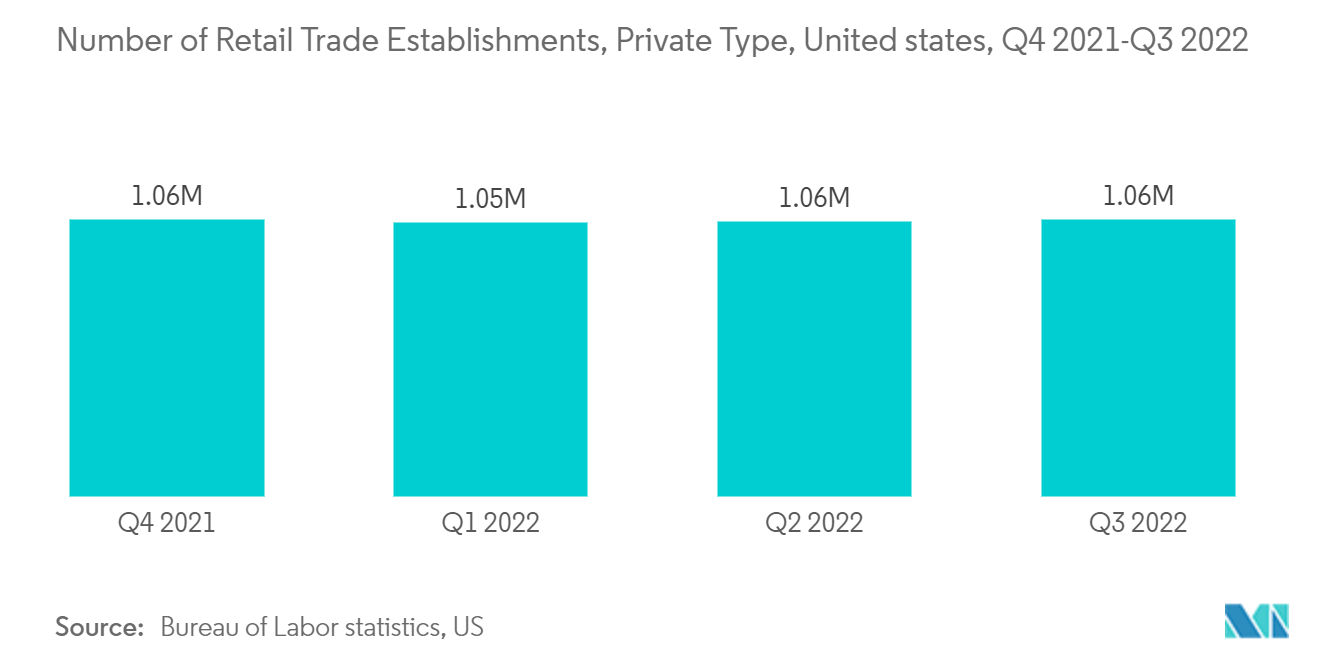
Asia-Pacific Market will be the Fastest Growing Market
- Asia-Pacific is one of the most significant regions to deploy AI-based Video surveillance systems to curb crimes and generate real-time data to integrate into the system. Being one of the hubs for the IT sector, the Ai base surveillance has helped the region attract many businesses worldwide for investment, thus generating revenues and attracting FDI, creating safe business opportunities for the residents.
- China is one of the largest country's video surveillance markets. The country has built a vast surveillance network that utilizes cameras powered by facial recognition software, including cameras installed on buildings, streets, and lamp posts that can identify individual faces. For instance, Dahua Technology launched its Cooper-I Series XVR, which offers AI functions, including SMD (Smart Motion Detection) Plus and AI Coding. These advanced features are enabled by default and eliminate extra configuration, making the installation process significantly easier and faster.
- India's Union Budget noted the country depends heavily on technology. It was made evident with the fiscal budget 2021 India believes AI-based video surveillance and AI/Ml technology will help shape technology in India. India Finance Minister Nirmala Sitharaman said during the Fiscal budget 2021-2022 that The Ministry of Corporate Affairs (MCA) 's revamped portal version 3.0, MCA 21, will use data analytics, AI, and machine learning to make regulatory filings easier for businesses. This will make MCA-21 a 'single point of information and promote ease of doing business, re-adjudication, and online compliance monitoring.
- The high installations of CCTV would create an opportunity for the players to develop new AI video analytics solutions to capture the market share. For instance, in June 2022, The command-and-control room for the city's effort to install closed-circuit television (CCTV) cameras was set up by the Nashik Municipal Smart City Development Corporation (NMSCDCL). Up to 800 CCTV cameras could be put throughout the city as part of this INR 169 crore project, and more than 100 cameras have already been installed. By December 2022, the remaining cameras were to be installed.
- Japan has been actively developing AI video analytics technologies in recent years. There are companies in Japan that specialize in developing AI video analytics for public safety and security, such as Konica Minolta and SoftBank. Additionally, organizations in Japan have been using AI video analytics in response to the pandemic, for example, to monitor social distancing or enforce mask-wearing. There are also companies in Japan that specialize in AI-based video surveillance solutions, such as Gorilla Technology Group. Bosch Security and Safety Systems in Japan offers a video surveillance (VSaaS) service that uses built-in video analytics for AI-based data analysis. Japan's government is also leading in regulating AI technology, focusing on creating multistakeholder and agile governance frameworks to address AI's impact.
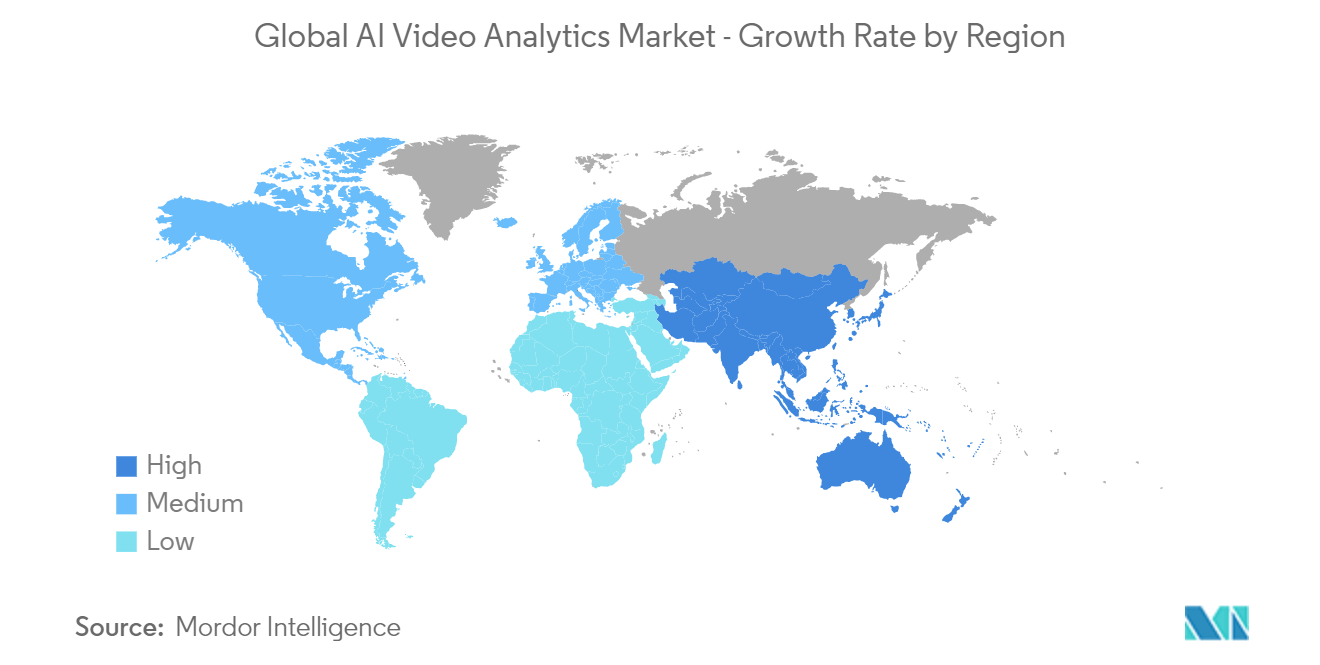
AI Video Analytics Industry Overview
The global AI video analytics market is semi-consolidated due to large vendors in the global market. The key players are involved in various strategies, such as acquisitions and partnerships, to improve their market share and enhance their profitability in the market.
In March 2023, Irisity AB (publ), a player in advanced video analytics, announced the release of Irisity Edge for Axis. Customers are expected to receive a comprehensive, intelligent video security system that blends best-in-class video analytics with market-leading surveillance cameras. The system runs Irisity's AI perimeter security algorithms embedded in the Axis camera without additional hardware. Irisity Edge for Axis combines Irisity's industry-leading video analytics based on deep learning AI models and machine learning with Axis Camera Applications Platform (ACAP) video devices.
In August 2022, Spin-off from MIT Derq, a real-time AI analytics solutions provider for linked roads and vehicles, teamed up with distributor Paradigm Traffic Systems to offer its AI video analytics and connected infrastructure solutions to Texas. Derq's advanced technologies were to be combined with Paradigm's strong market presence and long-standing customer relationships to improve road safety and smart traffic infrastructure in Texas.
AI Video Analytics Market Leaders
-
IndigoVision
-
Robert Bosch GmbH
-
AxxonSoft
-
Axis Communications AB
-
Panasonic Holdings Corporation
*Disclaimer: Major Players sorted in no particular order
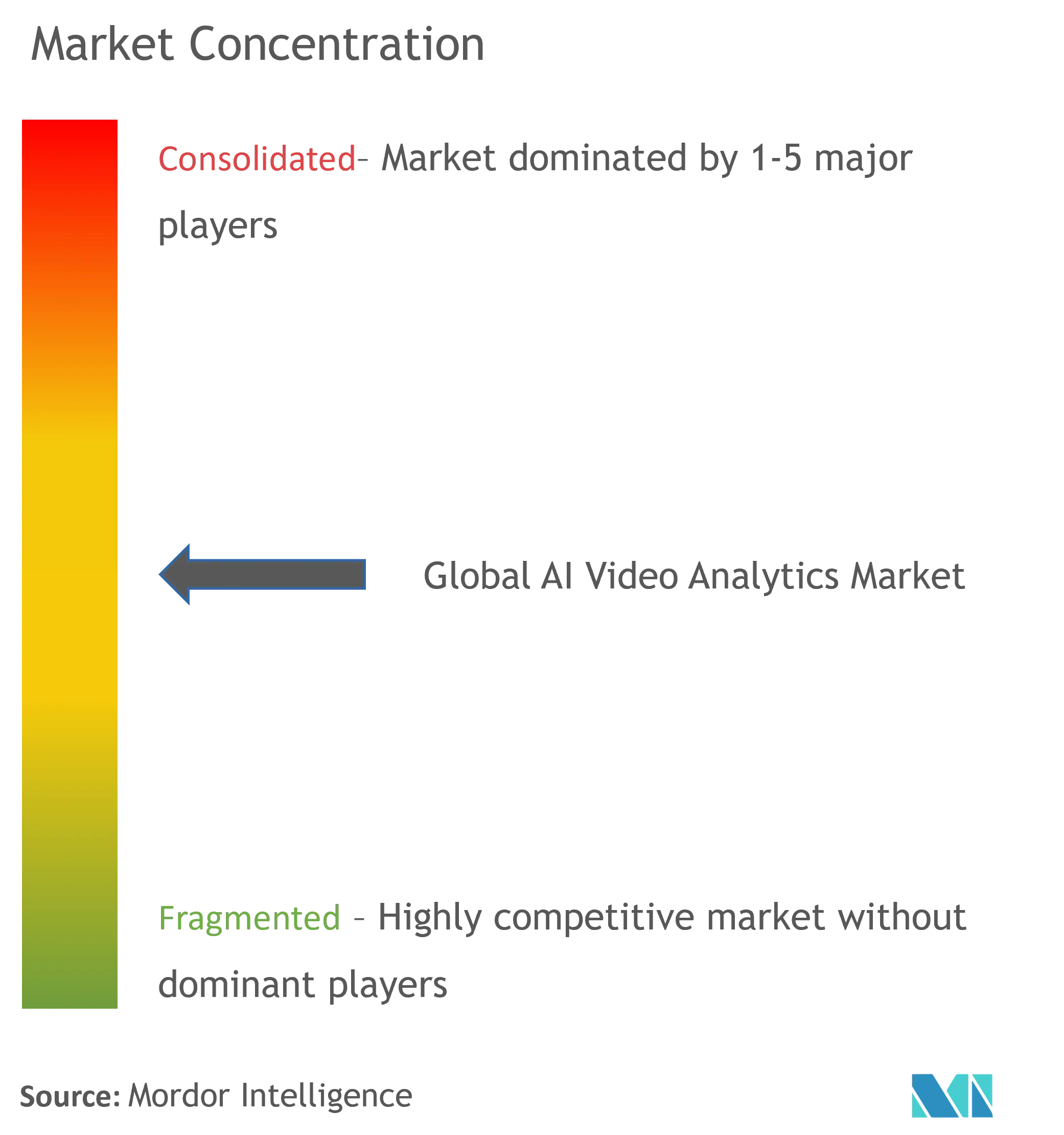
AI Video Analytics Market News
- January 2023: Remark Holdings, Inc., a diversified global technology business that provides artificial intelligence ("AI")-powered computer vision solutions, announced today its latest collaboration with AAEON, a leader in AI-Edge computing. This collaboration emphasizes the significance of providing market-ready solutions for smart cities that require visual solutions for greater public safety, situational awareness, and behavior analysis. The SSP AI-powered capabilities of Remark AI generate real-time notifications for proactive security and safety, such as Intelligent pre- and post-forensic inquiry that offers meta-data searches by leveraging physical and object-recognition qualities to expedite the investigation process. Intrusion, loitering, object, vehicle, and trespass detection
- June 2022: Viisights teamed with Iotech Protect, a leading provider of tailored digital and physical security, to provide AI-powered behavior detection video analytics to substantially boost real-time event recognition and automatic reporting. The partnership between Iotech Protect and Viisights applied to any business, including securing healthcare facilities, municipal infrastructure, transportation, schools and universities, retail malls, sports stadiums, workplaces, and warehouses.
AI Video Analytics Market Report - Table of Contents
1. INTRODUCTION
- 1.1 Study Assumptions and Market Definition
- 1.2 Scope of the Study
2. RESEARCH METHODOLOGY
3. EXECUTIVE SUMMARY
4. LWAN MARKET INSIGHT
- 4.1 Market Overview
-
4.2 Industry Stakeholder Analysis
- 4.2.1 Modules and other hardware vendors, platform vendors, network provider, integrators, end-users etc.)
-
4.3 Industry Attractiveness -Porter's Five Forces Analysis
- 4.3.1 Bargaining Power of Buyers/Consumers
- 4.3.2 Bargaining Power of Suppliers
- 4.3.3 Threat of New Entrants
- 4.3.4 Threat of Substitute Products
- 4.3.5 Intensity of Competitive Rivalry
- 4.4 Assessment of Impact of COVID-19 on the Market
5. MARKET DYNAMICS
-
5.1 Market Drivers
- 5.1.1 Need for enhanced public safety and security
- 5.1.2 Rising adoption of technologies such as facial recognition and object identification
- 5.1.3 Rapid increase in data flow due to integration of IoT sensors and devices
-
5.2 Market Challenges
- 5.2.1 Lack of skilled workforce to develop and integrate algorithms
- 5.2.2 Rising cyber attacks
6. MARKET SEGMENTATION
-
6.1 By End-User
- 6.1.1 Retail
- 6.1.2 Government and Defense (includes public safety)
- 6.1.3 Critical Infrastructure
- 6.1.4 Transportation
- 6.1.5 Healthcare
- 6.1.6 Consumers
- 6.1.7 Other End-Users (Education and Hospitality)
-
6.2 By Region
- 6.2.1 North America
- 6.2.2 Europe
- 6.2.3 Asia-Pacific
- 6.2.4 Latin America
- 6.2.5 Middle East & Africa
7. COMPETITIVE LANDSCAPE
-
7.1 Company Profiles
- 7.1.1 Axis Communication
- 7.1.2 Panasonic holDINGS
- 7.1.3 Bosch gmbh
- 7.1.4 Hikvision
- 7.1.5 IndigoVision
- 7.1.6 Intellivision
- 7.1.7 Avigilon
- 7.1.8 AxxonSoft
- 7.1.9 Dahua
- 7.1.10 NEC Corporation
- *List Not Exhaustive
8. INVESTMENT ANALYSIS
9. FUTURE OF THE MARKET
** Subject To AvailablityAI Video Analytics Industry Segmentation
Artificial intelligence for video analytics and surveillance leverages AI and ML algorithms that analyze the audio and images from video surveillance cameras to recognize humans, vehicles, objects, attributes, and events. This represents a sub-set of Video Analytics where AI-based capabilities are leveraged for implementing edge & centralized use cases.
The global AI Video Analytics Market is Segmented by End Users (Retail, Government, and Defense (including public safety), Critical Infrastructure, Transportation, Healthcare, and Consumers), and Geography (North America, Europe, Asia Pacific, Latin America, Middle East, and Africa).
The market sizes and forecasts are provided in terms of value (USD) for all the above segments.
| By End-User | Retail |
| Government and Defense (includes public safety) | |
| Critical Infrastructure | |
| Transportation | |
| Healthcare | |
| Consumers | |
| Other End-Users (Education and Hospitality) | |
| By Region | North America |
| Europe | |
| Asia-Pacific | |
| Latin America | |
| Middle East & Africa |
AI Video Analytics Market Research FAQs
How big is the Global AI Video Analytics Market?
The Global AI Video Analytics Market size is expected to reach USD 24.09 billion in 2024 and grow at a CAGR of 33% to reach USD 100.22 billion by 2029.
What is the current Global AI Video Analytics Market size?
In 2024, the Global AI Video Analytics Market size is expected to reach USD 24.09 billion.
Who are the key players in Global AI Video Analytics Market?
IndigoVision, Robert Bosch GmbH, AxxonSoft, Axis Communications AB and Panasonic Holdings Corporation are the major companies operating in the Global AI Video Analytics Market.
Which is the fastest growing region in Global AI Video Analytics Market?
Asia-Pacific is estimated to grow at the highest CAGR over the forecast period (2024-2029).
Which region has the biggest share in Global AI Video Analytics Market?
In 2024, the North America accounts for the largest market share in Global AI Video Analytics Market.
What years does this Global AI Video Analytics Market cover, and what was the market size in 2023?
In 2023, the Global AI Video Analytics Market size was estimated at USD 16.14 billion. The report covers the Global AI Video Analytics Market historical market size for years: 2019, 2020, 2021, 2022 and 2023. The report also forecasts the Global AI Video Analytics Market size for years: 2024, 2025, 2026, 2027, 2028 and 2029.
Global AI Video Analytics Industry Report
Statistics for the 2024 AI Video Analytics market share, size and revenue growth rate, created by Mordor Intelligence™ Industry Reports. AI Video Analytics analysis includes a market forecast outlook to for 2024 to 2029 and historical overview. Get a sample of this industry analysis as a free report PDF download.



